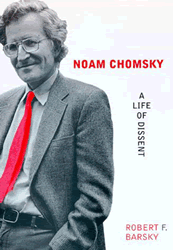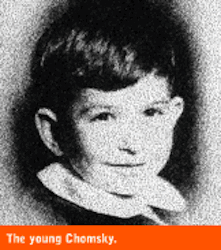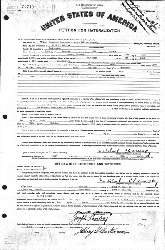#chmsk-1:
#chmsk-11
The Chomsky family ( of Kopil, Grodno area)
The Chomsky Household

Avram Noam Chomsky was born 7 December 1928 to Dr. William (Zev) Chomsky and Elsie Simonofsky, in Philadelphia, Pennsylvania. Dr. Chomsky had fled from his native Russia to the United States in 1913 in order to avoid being drafted into the Czarist army. Upon arrival, he worked in sweatshops in Baltimore, Maryland. He then managed to work his way through the Johns Hopkins University supporting himself by teaching in Baltimore Hebrew elementary schools. After moving to Philadelphia, he and his wife began teaching at the religious school of the Mikveh Israel congregation. Eventually, Dr. Chomsky was to become principal of this school
Dr. Chomsky continued to pursue his research in the field of medieval Hebrew language" and went on to become, according to a 22 July 1977 New York Times obituary, "one of the world's foremost Hebrew grammarians." He was the author of a seminal study called Hebrew, the Eternal Language (1957), as well as numerous other works, including Hebrew, the Story of a Living Language (1947; which was the basis of Hebrew, the Eternal Language), How to Teach Hebrew in the Elementary Grades (1946), and Teaching and Learning (1959). He also edited and annotated a study of thirteenth-century Hebrew grammar called David Kimhi's Hebrew Grammar (Mikhlol) (1952), a book that his son Noam read in an early form when he was about twelve years old. This kind of text, permeated with scholarly commentary and discussion, remains, even today, something that Chomsky enjoys enormously: "My idea of the ideal text is still the Talmud," he says. "I love the idea of parallel texts, with long, discursive footnotes and marginal commentary, texts commenting on At Mikveh Israel, students and professors associated with Gratz College practiced their teaching skills. In 1924, already teaching and acting as principal of Mikveh Israel, Dr. Chomsky was also appointed to the faculty of Gratz College, the oldest teacher's training college in the United States. Eight years later, he was made faculty president of Gratz, a position that he held for thirty seven years. Beginning in 1955, Dr. Chomsky began to teach, as well, at Dropsie College, a graduate school of Jewish and Semitic studies. He retired from Gratz in 1969, and from Dropsie in 1977, the year of his death.
 texts" (qtd. in Parini).
texts" (qtd. in Parini).
The impact that Chomsky's father had upon him seems clear in retrospect. Carlos Otero notes that "shortly before his death William Chomsky described the major objective of his life as `the education of individuals who are well integrated, free and independent in their thinking, concerned about improving and enhancing the world, and eager to participate in making life more meaningful and worthwhile for all.' It is hard to improve on this as a description of Noam Chomsky as an individual" ("Chomsky and the Libertarian Tradition" 5). William Chomsky was, furthermore, described by friends of the family as a very warm, gentle, and engaging individual. Bea Tucker, who worked as his secretary for a period of five years in the 1930s, recalls that he was a warm individual, considerate and generous with students and staff. When a teaching position opened up at Mikveh Israel in the mid-1930s, Tucker asked Dr. Chomsky if she could apply, hoping that this would be her opportunity to embark on a new career. He hired her, and she went on to teach David Eli Chomsky, Noam's younger brother and only sibling, as well as Carol Schatz, who would eventually become Noam's wife.
Chomsky's mother, Elsie, was equally important to his development as a thinker, a teacher, and an activist. Her political sensitivity motivated him, from a very young age, to look far beyond his immediate social context and into the realm of political action and involvement. She also taught Hebrew at Mikveh Israel, and so by the time her son was ready to enter the teaching profession himself, it had become, for him, a very familiar domain. According to Otero, "The influence of his father on him is easier to trace than that of his mother, née Elsie Simonofsky, who was more left oriented than her husband and appears to have made an impression on her son `in the area of general concern about social issues' and politics, `one major part of [Chomsky's] intellectual life'" ("Chomsky and the Libertarian Tradition" 4). One can only imagine the dinner-table conversation in such a household. As Otero goes on to tell us, Chomsky simply reports: "During childhood, there was always plenty of discussion in [our] home about really interesting and important issues" (16n10). Among those issues was a form of Zionism, at the time considered mainstream, that had been inspired by the West European Enlightenment. The Chomskys, Otero says, were particularly influenced by Asher Ginsburg (1856 1927), a Hebrew stylist and writer who acted as a spokesman for the advocates of this Zionist movement, who went by the pen name Ahad Haam, "one of the people." Ginsburg's Zionism is today considered by many to be anti-Zionist.
Elsie is described as having been rather more reserved than William. Bea Tucker describes her as "cool," "distant," and "incredibly brilliant." She, like her husband, had a towering intellect, and was greatly in demand as a speaker on scholarly and communal subjects. People such as Tucker, who knew the Chomsky family well, considered each of its members to be gifted, and from very early on, there was a general expectation that Noam and David would follow in the illustrious footsteps of their parents. In hindsight, Noam Chomsky does, indeed, seem to combine the qualities of both his parents. He is warm and accessible, despite his formidable stature. He is also reserved, quiet, and even somewhat shy. He is most certainly comfortable speaking to large audiences, but there is no question that his world is, for the most part, one of solitary study, writing, and research.
From a very early age, Noam and David were immersed in the scholarship, culture, and traditions of Judaism and the Hebrew language through the work of both of their parents. David was also an exceptional child, and also active in family discussions. And, of course, Noam and David spent lots of time together. They enjoyed playing "basketball (of a sort) with some kind of rubber ball we found and a makeshift bushel basket with the bottom knocked out that I managed to tack on to the house wall next to a driveway" (16 Nov. 1995).
Those who knew both David and Noam as children agree that although the two were close, David did keep a somewhat lower profile than his older brother and possessed an easier temperament. Even as a young child, Noam was very competitive, trying, according to Bea Tucker, to "outdo his parents." She recalls an incident that occurred while she was visiting the Chomskys during a vacation they took in 1935. Noam was just seven years old. When William and Elsie left the room, Tucker found herself alone with him. To make conversation, she pointed to Compton's Encyclopaedia and asked Noam if he had looked through any of the volumes. "I've only read half of them," was Noam's reply. In short, Noam was, in the words of Bea Tucker, the "brain," while David was the "nice guy." David had the easygoing character of his father, while Noam was more aloof, like his mother. David went on to study medicine, and still lives and works in Philadelphia.
Noam and David were deeply marked by a remarkable home life. The entire Chomsky family was actively involved in Jewish cultural activities and Jewish issues, particularly the revival of the Hebrew language and Zionism. Chomsky told interviewer Eleanor Wachtel, "I would read Hebrew literature with my father from childhood nineteenth and twentieth century Hebrew literature, and of course older sources. I spent my time in Hebrew school, later became a Hebrew teacher, and out of all of this my political interests converged to an interest in Zionism" (65). Carol Doris Schatz recollects that in Hebrew school Noam would take the lead in discussions. Carol and Noam remained close, and were eventually married; they have stayed together to this day. Bea Tucker remembers Carol Schatz as a very bright and warm girl. Carol's father was a medical doctor, and her family, like the Chomskys, was highly regarded in the community. Chomsky says that he "met" Carol "when I was about five and she was about three, when my parents went to visit her parents at a summer cottage near Philadelphia. Probably occasionally after that. I doubt if we spoke a serious word until she was maybe fourteen or so. Her older sister was a classmate of mine in Hebrew school, and her still older brother was the leader of the synagogue choir, and in that capacity, taught the kids there to chant their Bar-Mitzvah portions (me too)" (13 Feb. 1996).
It is certainly not surprising that, "as a boy of 9, in 1938, [Noam] used to sit in the front row of the Hebrew class at Mikveh Israel ... paying little attention to the teacher [who happened, on occasion, to be his mother]. He was not being disrespectful; he happened to have covered the ground long before, at home, with his parents" (Otero, "Third Emancipatory Phase" 22). Said Itzhak Sankowsky, one of his Hebrew teachers, "it was expected from his family background that he should know more Hebrew than anybody else. Superficially, you couldn't tell there was something unusual there. You had to bring it out with a debate or a bit of knowledge. Then you knew" (qtd. in Yergin 41).
The Extended Family
Politically, Noam's parents were "normal Roosevelt Democrats," although many members of the next level of family cousins and aunts and uncles were part of a Jewish working class with ties to various strains of communism. Chomsky remarks that "several were seamstresses, but these were the days of union building. They were in the ILGWU, which was then finally getting people out of sweatshops (when they had work, that is; they were usually unemployed). Others were involved in everything from ordinary labo[r] to petty commerce to school teaching (for those who managed to work their way through school themselves)" (13 Feb. 1996). Many were involved in the radical political movements that thrived during the Depression. Chomsky explains: "Some were in the Communist Party, some militantly anti-Communist Party (from the left), some Roosevelt Democrats, and everything else from left-liberal to anti-Bolshevik left (whether the Communist Party fits in that spectrum is not obvious, in my opinion)" (31 Mar. 1995). That such diversity of political affiliation should exist within a single family was not unusual among Russian emigrés of the time, and Noam and David undoubtedly benefited from being exposed to a wide range of opinion. Within the extended Chomsky-Simonofsky family, issues were not resolved according to a narrow, status quo set of principles, which meant that Noam and David were given freer rein in their own choices. Their environment as a whole parents, relatives, school, community encouraged the brothers to engage in careful observation and analysis; no single approach to an issue was deemed adequate.
Chomsky was further marked by the socioeconomic situation of the period. He came of age in Quaker Philadelphia during the Depression; he told Wachtel that his early childhood memories included "seeing people coming to the door and trying to sell rags or apples," and " travelling in a trolley car past a textile factory where women were on strike, and watching riot police beat the strikers" (64). And the neighborhood in which the Chomsky family lived was inhabited mainly by Germans and Irish Catholics, who were, for the most part, anti-Semitic and pro-Nazi. Not all children raised under such circumstances develop a social conscience, but it is fair to say that Chomsky, who was immersed in an alien cultural tradition within a community of immigrants, had many occasions to stare hypocrisy and violence in the face and wonder about their sources.
For the rest go to: http://cognet.mit.edu/library/books/chomsky/chomsky/1/3.html
Also; http://www.chomsky.info/
William ( Welel)Chomsky

U.S. World War II Draft Registration Cards, 1942 Record for William Chomsky
Name: |
William Chomsky |
Birth Date: |
15 Jan 1897 |
Birth Place: |
Kupel, Russia |
Residence: |
Philadelphia, Pennsylvania |
Wife; Elsie Chomsky
Works at Gratz College; Height; 5’6 wait; 127
1930 census;
Name: |
William Chomsky |
||||||||||
Home in 1930: |
Philadelphia, Philadelphia, Pennsylvania |
||||||||||
Age: |
32 |
||||||||||
Estimated birth year: |
abt 1898 |
||||||||||
Birthplace: |
Russia |
||||||||||
Relation to Head of House: |
Head |
||||||||||
Spouse's name: |
Elsie |
||||||||||
Race: |
White |
||||||||||
Occupation: |
|
||||||||||
|
|
||||||||||
Household Members: |
|
Aviva Chomsky (born April 20, 1957) is currently a professor and the coordinator of Latin American studies at Salem State College, Massachusetts. She was previously a professor at Bates College and a faculty research associate at Harvard University, specializing in the history of Latin America and the Caribbean. She is the eldest daughter of linguist and political activist Noam Chomsky, Massachusetts Institute of Technology, born 1928. Her grandfather was Professor of Hebrew and Principal of Gratz College, Melrose Park, Pennsylvania, for many years, William Chomsky, (1896 -Philadelphia, 1977, aged 81).
Her book West Indian Workers and the United Fruit Company in Costa Rica 1870–1940 relates the history of the US-based companies which built railroads and cultivated bananas on the Atlantic Coast of Costa Rica and which merged to form United Fruit in 1899. It also describes how the workers, including many Jamaicans, originally of African descent, developed their own parallel socio-economic system. The book was awarded the 1997 Best Book Prize by the New England Council of Latin American Studies.
She has also co-edited books including The People Behind the Coal, Identity and Struggle at the Margins of the Nation-State, and The Cuba Reader: History, Culture, Politics (Latin America Readers).